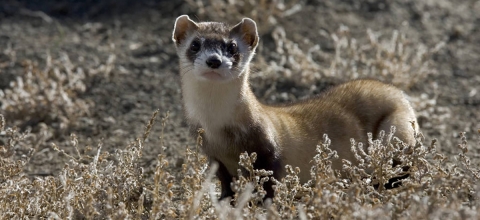Endangered Species Act Milestones: 1980s
The 1980s were the dawning of a new era in the conservation movement, and the decade started dramatically with declaration of a moratorium on commercial whaling in 1981, which benefitted many whale species in danger of extinction. As the American public watched E.T. phone home and marveled over the digital compact disc (cd), conservationists celebrated the first Habitat Conservation Plan and the first delisting of a species – the brown pelican – due to recovery. Along with these conservation firsts, actions carried out under the ESA gave some of the nation's rarest species a second chance. The last remaining wild black-footed ferrets, California condors, and red wolves were captured in the '80s for intensive captive breeding programs—last ditch efforts to save these species from extinction.
1981
- Secretary of the Interior James Watt seeks to redefine the regulatory definition of "harm."
- The International Whaling Commission decides to enact a moratorium on all commercial whaling, after the reports of the Convention on International Trade in Endangered Species in 1977 and 1981 identify many species of whales as in danger of extinction.
- The Lacey Act is amended, making unlawful the interstate and foreign shipment of wildlife and plants taken, possessed, transported, or sold in violation of federal, tribal, state, or foreign law unlawful.
- A ranch dog retrieves a black-footed ferret near Meeteetse, Wyoming, renewing recovery efforts for the species once believed to be extinct.
1982
- The ESA Amendments of 1982, which allow, by permit, the take of listed wildlife species incidental to otherwise lawful activities, provide that the permit holder implements a Habitat Conservation Plan. The 1982 Amendments also include a prohibition against collecting listed plants on federal lands.
1983
- The first Habitat Conservation Plan is approved for the San Bruno elfin butterfly and San Francisco garter snake in San Bruno Mountain, California.
1985
- The first species is delisted, or removed from the Federal List of Endangered and Threatened Wildlife and Plants, following recovery: the brown pelican.
- The Palau ground dove, the Palau owl, and the Palau fantail are delisted following recovery.
- Researchers discover fleas positive for sylvatic plague at Meeteetse, Wyoming. After much debate, biologists decide to capture some black-footed ferrets for a captive breeding program. Learn more about the National Black-footed Ferret Conservation Center.
1987
- The American alligator is delisted following recovery.
- The red wolf is reintroduced back into the wild at Alligator River National Wildlife Refuge in eastern North Carolina, after a nearly 7 year absence. Learn more about red wolf recovery.
- The last dusky seaside sparrow dies in captivity.
1988
- The ESA Amendments of 1988, which includes the creation of an annual expenditures report for monies spent on endangered species conservation by all federal and state agencies, and several new criteria for planning for species recovery.
- The U.S. Fish and Wildlife Service captures the last nine wild California condors from the wild in an effort to prevent the species' extinction through captive-breeding programs at the San Diego and Los Angeles Zoos.
1989
- Importing ivory into the United States is banned to help protect the African elephant.




